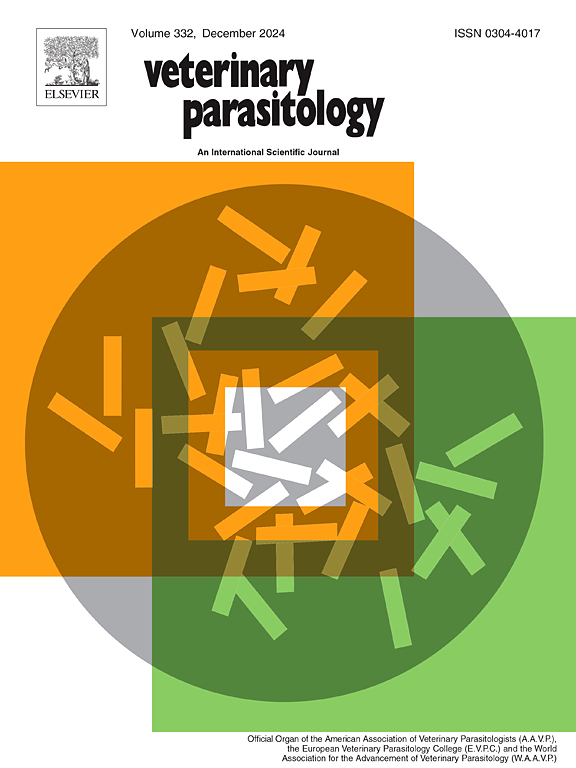Coxiella R1 symbiont regulates the Asian long-horned tick on its reproduction and development
IF 2
2区 农林科学
Q2 PARASITOLOGY
引用次数: 0
Abstract
The Asian long-horned tick Haemaphysalis longicornis, is a hematophagous ectoparasite that causes important public and veterinary health concerns. Different species of ticks harbor a symbiont bacterium of the genus Coxiella. A Coxiella sp. bacterial endosymbiont was highly prevalent in laboratory-reared H. longicornis. The endosymbiont sequence was 100 % identical to those of H. longicornis Coxiella-like endosymbionts and thus named Coxiella R1 in the present study. Coxiella R1 was detected in all stages of tick and in greatest numbers in nymphs and unfed adult females. We manipulated the numbers of Coxiella R1 in ticks by injecting engorged females or capillary tube feeding of flat females with tetracycline. Both of the administration routes were efficient in reducing the symbiont densities. Microinjection of tetracycline solution reduced 25.53 % of Coxiella R1 in eggs harvested just before hatching, whereas, the reduction rate for capillary tube feeding climbed to 81.70 %. Ticks with Coxiella R1 suppression laid abnormal eggs which were wrinkled, flat, and black, and linked each other to form a line. Ticks that had been treated with tetracycline had lower hatching rates in comparison to controls. In addition, larvae with tetracycline treatment less infested hosts and thus had lower engorgement rates than ticks that received PBS alone. The findings indicate that Coxiella R1 is a primary and obligate endosymbiont, and capable of modulating the obligately hematophagous parasites in egg laying and hatching, and larva blood feeding. The results also suggest that tetracycline treatment could be added to an integrated pest management tool menu for control of the Asian long-horned ticks.
Coxiella R1共生体调控亚洲长角蜱的繁殖发育
亚洲长角蜱长角血蜱是一种吸血的体外寄生虫,引起重要的公共和兽医卫生问题。不同种类的蜱含有一种科希氏菌属的共生细菌。实验室饲养的长角天牛中普遍存在一种Coxiella细菌内共生体。该内共生体序列与长角锥虫Coxiella-like内共生体序列100% %相同,故命名为Coxiella R1。Coxiella R1在蜱虫各阶段均有检出,以若虫和未被喂养的成年雌蜱最多。用四环素注射充血雌蜱或用毛细管喂养扁平雌蜱来控制蜱体内Coxiella R1的数量。两种给药途径均能有效降低共生体密度。在刚孵化的卵中,微量注射四环素溶液可使Coxiella R1降低25.53 %,而毛细管喂养可使Coxiella R1降低81.70 %。对Coxiella R1抑制的蜱所产异常卵呈皱褶、扁平、黑色,并相互串连成一行。与对照组相比,用四环素治疗的蜱虫的孵化率较低。此外,与单独接受PBS治疗的蜱相比,四环素治疗的幼虫感染宿主较少,因此其膨胀率较低。结果表明,Coxiella R1是一种初级专性内共生体,能够调节专性食血寄生虫的产卵、孵化和幼虫取血。结果还表明,四环素治疗可以添加到综合虫害管理工具菜单中,以控制亚洲长角蜱。
本文章由计算机程序翻译,如有差异,请以英文原文为准。
求助全文
约1分钟内获得全文
求助全文
来源期刊

Veterinary parasitology
农林科学-寄生虫学
CiteScore
5.30
自引率
7.70%
发文量
126
审稿时长
36 days
期刊介绍:
The journal Veterinary Parasitology has an open access mirror journal,Veterinary Parasitology: X, sharing the same aims and scope, editorial team, submission system and rigorous peer review.
This journal is concerned with those aspects of helminthology, protozoology and entomology which are of interest to animal health investigators, veterinary practitioners and others with a special interest in parasitology. Papers of the highest quality dealing with all aspects of disease prevention, pathology, treatment, epidemiology, and control of parasites in all domesticated animals, fall within the scope of the journal. Papers of geographically limited (local) interest which are not of interest to an international audience will not be accepted. Authors who submit papers based on local data will need to indicate why their paper is relevant to a broader readership.
Parasitological studies on laboratory animals fall within the scope of the journal only if they provide a reasonably close model of a disease of domestic animals. Additionally the journal will consider papers relating to wildlife species where they may act as disease reservoirs to domestic animals, or as a zoonotic reservoir. Case studies considered to be unique or of specific interest to the journal, will also be considered on occasions at the Editors'' discretion. Papers dealing exclusively with the taxonomy of parasites do not fall within the scope of the journal.
 求助内容:
求助内容: 应助结果提醒方式:
应助结果提醒方式:


